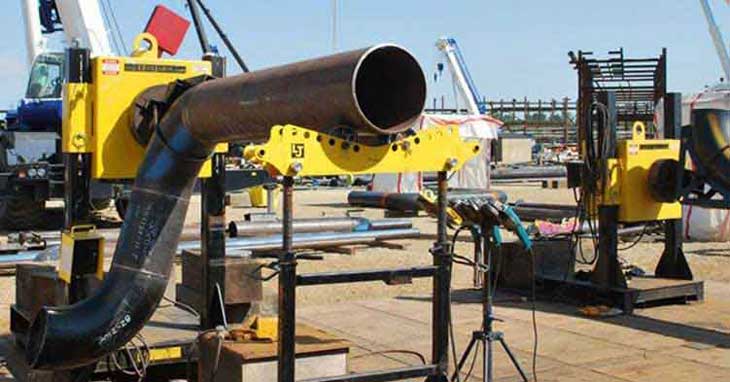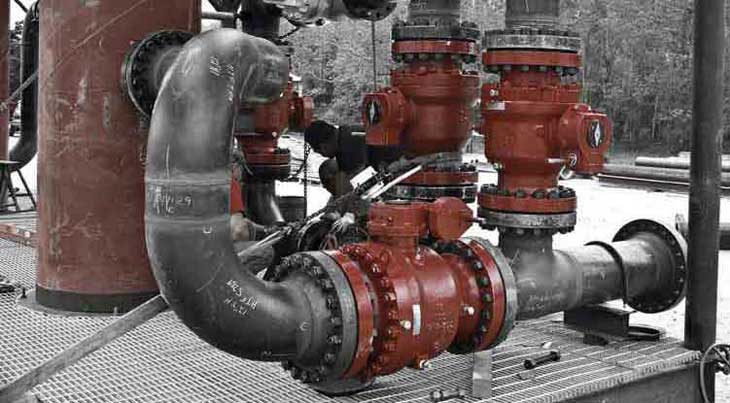Field Fabrication of Piping spools
The installation of pipe systems follows its fabrication and is very frequently a part of it. The installation of pipe can be accomplished in the following two primary ways, or combinations thereof..
- Field fabricate and install
- Shop fabricate and field erected
Some contractors prefer to do most, if not all fabrication in the shop, others prefer to set up at the job-site, while others are flexible enough to utilize the best of both methods.
Field fabrication and installation is exactly what it means. The pipe is fabricated on-site, either directly at the place where it is mounted, or in a temporary accommodation in the field.
A number of factors will determine whether it is profitable to fabricate pipe on site..
Type of project, size and scope of the project, pipe size and material, accessibility of the equipment, surface treatment after fabrication, weather conditions, availability of qualified personnel, time available to do the job, etc..
Pros and Cons of Field fabrication
Advantages of Field fabrication
- Only raw material (pipe, fittings, valves, etc.) need to be shipped to the site location. This is much easier to handle and store than multi-plane configurations of pre-fabricated pipe.
- No time-consuming need to carefully crib, tie-down and chock pre-fabricated *spool pieces for transport to the job site.
- Reduced risk of damage to spool pieces.
- More efficient opportunity to fab around unexpected obstacles (structural steel, duct, cable tray, etc.)
- Fabricate-as-you-install reduces the rework risk assumed when pre-fabricating spools, or the cost related to field verification prior to shop fabrication.
- The field routing installation of pipe through an array of insufficiently documented locations of existing pipe and equipment, on a retrofit project, is quite frequently more effective than attempting to pre-fabricate pipe based on dimensional assumptions.
Disadvantages of Field fabrication
- Weather is arguably the biggest deterrent. If the facility under construction is not enclosed then protection from the elements will have to be provided.
- When welding has to be done in conditions that are not environmentally controlled then pre-heating will be required if the ambient temperature (not the metal surface temperature) is 0° F or below.
- In a new facility, as opposed to having to route piping through an array of poorly located existing pipe and equipment, field fabrication of buttwelded pipe is not as efficient and cost effective as shop fabrication.
- Concerns about safety and efficiency when working in a facility while it is in operation in advance of a turnaround or to begin advance work on a plant expansion.
Generally speaking, threaded, socketweld, grooved, and other proprietary type joints that do not require buttwelding are field fabricated and installed. Buttwelding of small (bore), NPS 1.1/2 and less, are very often field fabricated and installed because of the added risk of damage during transport, in pre-fabricated form, from the shop to the site.
Pipe rolling machine in Field Fabrication
 Image..www.ljwelding.com
Image..www.ljwelding.com
Existing (in operation) or a new production plant.
A very important aspect is where the work must be done.. Into a existing (in operation) or a new production plant?
During the construction of a new plant, the work can generally be carried out in the same way as for example in a fabrication shop. Installation and making field welds require no special authorisation. Transports with, e.g., a forklift truck and lifting with cranes require no special permits, etc.
In an existing plant in operation, the conditions are totally different as during construction of a new plant.
In general, for all activities work permits are necessary. For activities with open flames (welding, cutting etc.) and also for combustion engines, so called Hot-Permits are required.
The contractor often can not determine when a scheduled task can be performed, because it depends on plant operators, who should or should not give permission for a particular job.
In short, in an existing plant in operation, high risks are present, and the contractor can probably scheduled tasks do not always perform according to his planning.
Shop fabrication and install
Shop fabrication is, generally speaking, any pipe, fittings and components that are assembled by welding into spool assemblies at the fabricator's facility. The spools are then labeled with an identifier and transported to the job site for installation.
Each spool piece needs its own identifier marked on the piece itself in some fashion that will make it easy to know where its destination is in the facility and/or where it belongs in a multi-spool system of pipe. This will allow the installer to efficiently stage the piece and ready it for installation.
As part of the process of developing spool sections field-welded joints need to be designated. These are welded joints that connect the pre-fabricated spools. In doing this the designer or fabricator will identify two different types of field-welded joints.
One is a Field Weld (FW) and the other is a Field Closure Weld (FCW). The FW indicates a joint in which the end of a pipe segment is prepared for the installer to set in place and weld to its connecting joint without additional modification in the field. This means that the length of pipe that is joined to another in the field is cut precisely to length and the end prepared in the shop for welding.
The FCW provides the installer with an additional length of pipe, usually 100 to 150 mm longer than what is indicated on the design drawings, to allow for field adjustment.What has to be considered, and what prompts the need for a FCW, is the actual, as-installed, location of both the fixed equipment that the pipe assemblies may connect to and the actual installed location of the pipe assembly itself. Odds are that all equipment and piping will not be installed exactly where indicated on design drawings.
The dimensional location of the equipment items given on design drawings is not a finite location, they are merely intended locations, as are drawings for building steel, pipe supports and others. What factors into the installation of shop fabricated pipe is the actual location of the equipment nozzle it will be connecting to in relation to the pipe's installed location.
In connecting to equipment there is a build-up, or stack-up, of tolerances that will effectively place the actual, or final, location of the nozzle at some point in the xyz geometry of three-dimensional space, other than where the design drawing indicates. The tolerance stack-up comes from the following..
- Manufacturing tolerances in material forming, nozzle location, and vessel support location.
- The actual set-in-place location of the vessel.
- Load cell installation (when applicable).
- The actual set-in-place pipe run-up location.
In order to allow for these inevitable deviations between the drawing dimensions used to fabricate the vessel, set the vessel, and install the pipe assembly, and the actual installed location of the connecting points, a field closure piece, or two, will be required for that final adjustment.
The field closure piece is a designated section of the pipe assembly in which a field weld has been indicated. The section with the field closure weld would be the length required to agree with that indicated on the design drawing, plus an additional 100 to 150 mm (more or less depending on fabricator's comfort level with the equipment locations). What this does is allow the field to make the final determination in the adjustments when connecting to fixed equipment.
Field installation of Pipe Spools

Environment
The environment is only a factor when work has to be done in an open-air structure or other outdoor installation (tank farm, pipeline, pipe rack or yard piping, etc.). Working in an open air structure will require protection from the elements (rain, snow, wind, cold, etc.). There may additionally be a requirement to work in elevated areas on scaffolding and otherwise. All of this can have a potential impact on safety and efficiency.
Pipe rack installation consists mainly of straight runs of pipe, and will not necessarily have a requirement or need for pre-fabrication. That is, unless it is pre-fabricated as modular skid units. Depending on the project it could be cost effective on an overall strategic basis to modularize the pipe rack, steel and all.
The big advantage to shop fabrication is the controlled environment in which it's done. This includes the Quality Control aspect, better equipment (generally speaking), a routine methodology of how a piece of work progresses through the shop, and better control, through a developed routine, of required documentation.
Range of Pipe Material and Sizes
Shop fabricated spools need to be transported to the job site. This requires handling. Handling and transporting small diameter pipe and/or thin-wall tubing spools creates the potential for damage to those spools.
If you are shop fabricating everything and the distance from shop to site is simply across town the risk to damaging small diameter pipe spools is a great deal less than if they have to be shipped half way across the US, Europe or Asia. Or even across an ocean.
In transporting spools over long distances, unless there is a great deal of thought and care given to cribbing the load of spools, it may not be beneficial to transport buttwelded pipe spools NPS 1.1/2 and less. It may be more practical to fabricate these sizes on site, unless you are fabricating hygienic or semi-conductor piping. These types of systems require a great deal more control and a cleaner fabrication. Meaning that pipe fabrication will require a clean shop area on-site, or the pipe will need to be fabricated at an off-site, better controlled shop facility.
Petroleum refining and bulk chemical projects are generally open air projects in which field fabrication and installation of pipe is exposed to the elements. While a clean build is not a requirement on these types of projects efficiency and, above all, safety is, as it is on any type project. Because of this, it would make sense to utilize shop fabrication as much as possible.
Fabricating pipe spools under better controlled shop conditions will provide improved efficiency and safer per hour working conditions over what you will generally find in the field. This translates into fewer accidents.
| Reference.. Chemical Engineering Magazine, W. M. (Bill) Huitt |